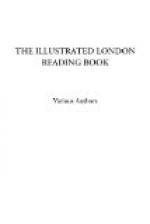SIR JAMES ALEXANDER.
* * * * *
THE SLOTH.
[Illustration]
The Sloth, in its wild condition, spends its whole life on the trees, and never leaves them but through force or accident; and, what is more extraordinary, it lives not upon the branches, like the squirrel and the monkey, but under them. Suspended from the branches, it moves, and rests, and sleeps. So much of its anatomical structure as illustrates this peculiarity it is necessary to state. The arm and fore-arm of the sloth, taken together, are nearly twice the length of the hind legs; and they are, both by their form and the manner in which they are joined to the body, quite incapacitated from acting in a perpendicular direction, or in supporting it upon the earth, as the bodies of other quadrupeds are supported by their legs. Hence, if the animal be placed on the floor, its belly touches the ground. The wrist and ankle are joined to the fore-arm and leg in an oblique direction; so that the palm or sole, instead of being directed downwards towards the surface of the ground, as in other animals, is turned inward towards the body, in such a manner that it is impossible for the sloth to place the sole of its foot flat down upon a level surface. It is compelled, under such circumstances, to rest upon the external edge of the foot. This, joined to other peculiarities in the formation, render it impossible for sloths to walk after the manner of ordinary quadrupeds; and it is indeed only on broken ground, when he can lay hold of stones, roots of grass, &c., that he can get along at all. He then extends his arms in all directions in search of something to lay hold of; and when he has succeeded, he pulls himself forward, and is then enabled to trail himself along in the exceedingly awkward and tardy manner which has procured for him his name.
Mr. Waterton informs us that he kept a sloth for several months in his room, in order to have an opportunity of observing his motions. If the ground were rough he would pull himself forward in the manner described, at a pretty good pace; and he invariably directed his course towards the nearest tree. But if he was placed upon a smooth and well-trodden part of the road, he appeared to be in much distress. Within doors, the favourite position of this sloth was on the back of a chair; and after getting all his legs in a line on the topmost part of it, he would hang there for hours together, and often with a low and plaintive cry would seem to invite the notice of his master. The sloth does not suspend himself head downward, like the vampire bat, but when asleep he supports himself from a branch parallel to the earth. He first seizes the branch with one arm, and then with the other; after which he brings up both his legs, one by one, to the same branch; so that, as in the Engraving, all the four limbs are in a line.




